More than 70 percent of the planet’s surface is covered by the oceans, which are responsible for an estimated 50 – 80 % of the oxygen production and also supporting a myriad of tiny living organisms and larger creatures.
Yet, so little is known about our oceans and the multitude of marine animals inhabiting the deep waters. In fact, more than eighty percent of our ocean is still unmapped, unobserved, and remain unexplored, with less than ten percent of the worldwide ocean being mapped with the aid of modern sonar technology.
While the oceans are home to a variety of exquisitely colored fish and other sea creatures with the most extraordinary appearances, others have some particular physical traits that may not be exactly considered as aesthetically pleasing. More precisely, some of these critters are right on terrifying-looking, enough to instigate fear in the most faint of hearts and keep them wide awake at night!
We have compiled 12 of the most unusual and creepy looking sea creatures that may get you to peek through your fingers.
1. Atlantic wolffish
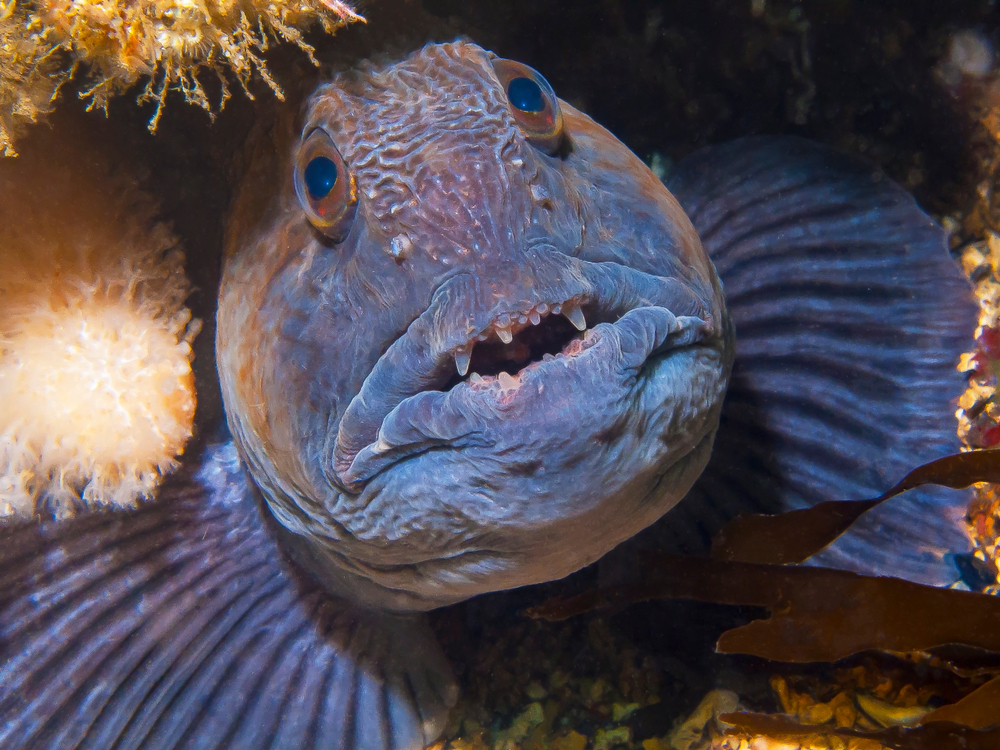
The Atlantic wolffish (Anarhichas lupus), also referred to as the seawolf, Atlantic catfish and wolf eel among other names, is a marine fish of the wolffish family Anarhichadidae, inhabiting the west and east coasts of the Atlantic Ocean. Atlantic wolffish exist in various colors, although they are usually seen as purplish-brown, a light grayish-green, a dull olive green or bluish gray. They are a rather large fish with an elongated, tapering body and a relatively large head compared to their bodies. The largest specimen recorded measured 1.5 m (5 ft) long and weighed almost 18 kg (40 lb).
One of their distinctive feature is their blunt, rounded snouts with sharp, protruding teeth which gave rise to their common name ‘wolffish’. The lower and upper jaws are equipped with 4-6 fang-like, strong, conical teeth and behind these in the upper jaw, 3 rows of crushing teeth. The central row contains 4 pairs of molars and the outer rows have blunted conical teeth. Behind the primary conical teeth in the lower jaw are 2 rows of molars. Also, several serrated teeth are scattered throughout the throat.
2. Spotted handfish
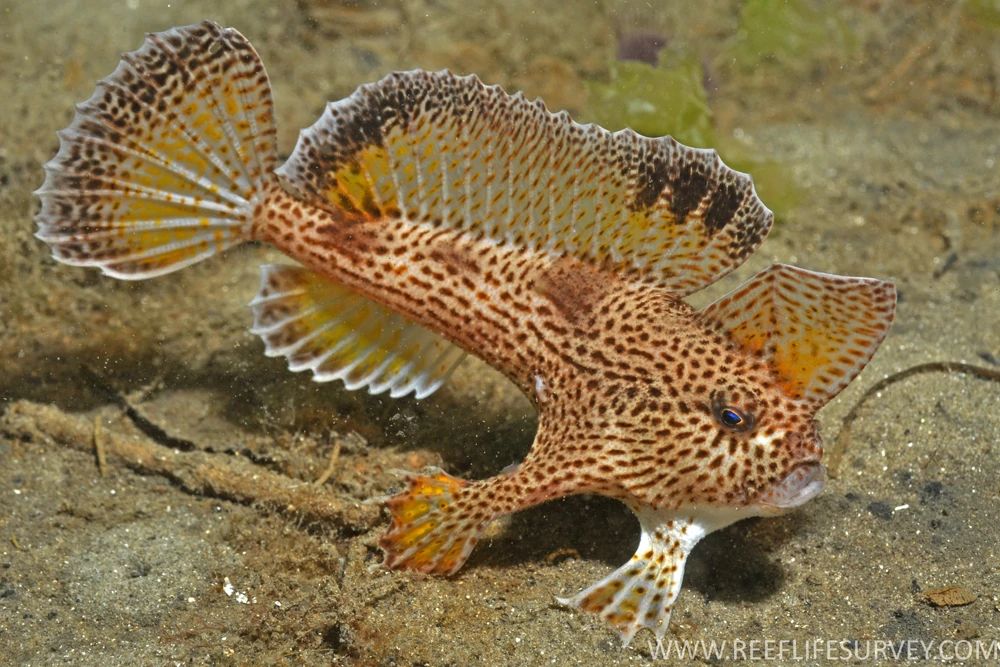
The Spotted handfish (Brachionichthys hirsutus) is a rare Australian fish in the handfish family, Brachionichthyidae. As a small species, it measures up to 12 cm (4.7 in) in length and is normally found at depths of 5 m to 10 m (16 to 33 ft).
It is a strange-looking fish due to its highly adapted pectoral fins, which resemble legs with hand-like extremities and allow the creature to walk on the sea floor. In fact, it is a slow-moving fish which prefer to ‘walk’ rather than swim. This species has a pinkish upperside and a white ventral side with darker orange, brown or blackish spots. There is a high first dorsal fin emerging from the snout and a long based soft-rayed dorsal fin. The Spotted Handfish has an extremely restricted distribution, partly as a consequence of its unusual life cycle and is classified as Critically Endangered on the IUCN Red List 2020.
3. Blobfish

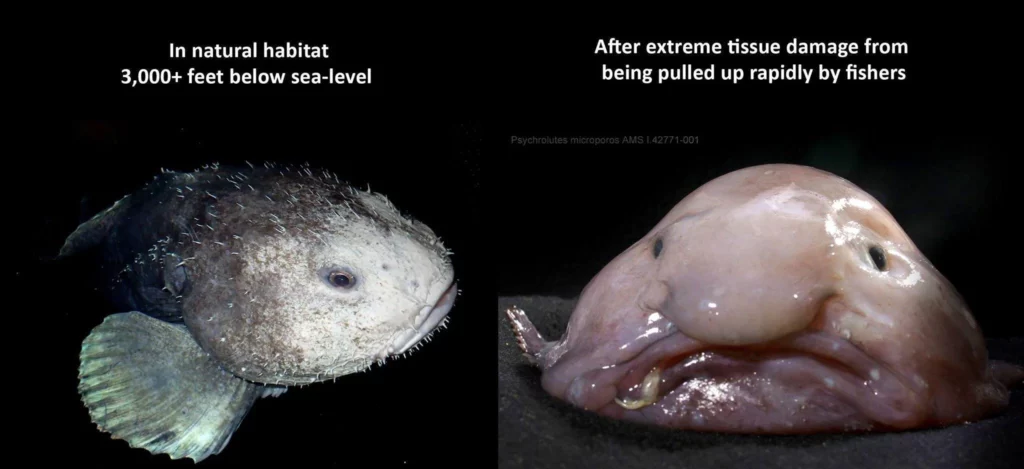
Psychrolutes marcidus, known as the smooth-head blobfish or simply as blobfish, is a deep-sea fish of the family Psychrolutidae. It is usually shorter than 30 cm (12 in) and lives off the coast of Australia, Tasmania and also New Zealand at depths between 600 and 1,200 m (2,000 and 3,900 ft), where the pressure can be 60 to 120 times higher than that at the surface.
The popular image of the blobfish that we encounter most of the time is the one where it appears like a gelatinous mass, all droopy and saggy. But this is partly due to the result of the decompression damage caused to specimens when they are removed from the extreme depths they inhabit and brought to the surface. In their natural environment, the blobfish has a more common appearance for its superclass Osteichthyes (bony fish). The blobfish doesn’t have a swim bladder, and neither a skeleton really, nor any muscles, which explains its saggy appearance at the surface. Actually, super-deep fish often have minimal skeletons and jelly-like flesh, as having water as their structural support is the only way to withstand the enormous pressure of the deep sea.
4. Humpback anglerfish
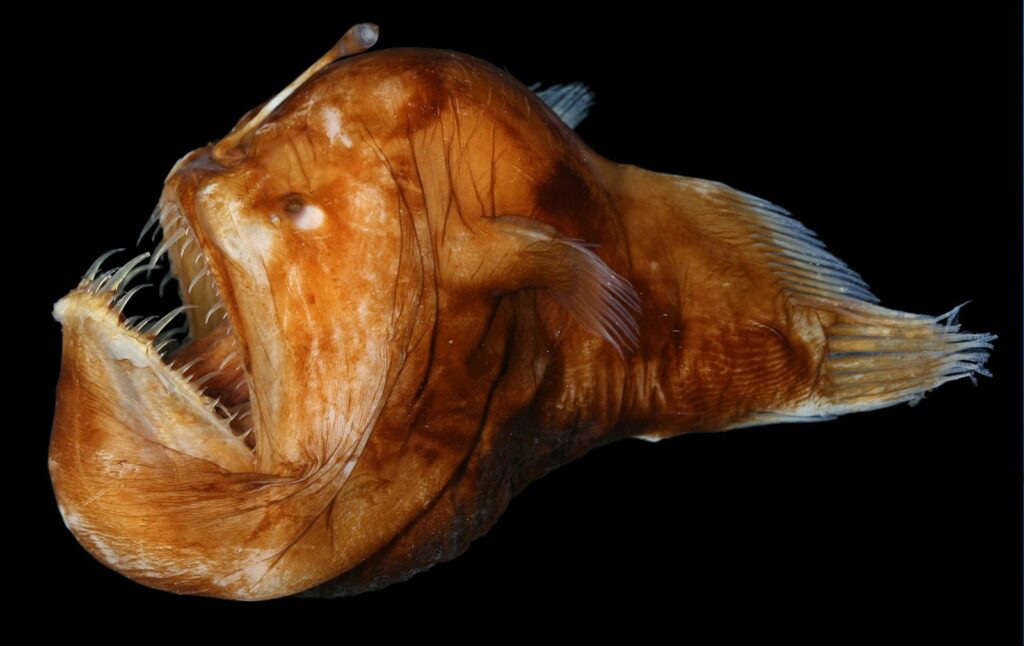
Credit: oceana.org
Melanocetus johnsonii, known by its common names, Deep sea anglerfish or Humpback anglerfish, is a species of black seadevils in the family of Melanocetidae. It is a soft-bodied anglerfish that is dark brown or black in color and usually found at depths of 100 – 1500 m (330 – 4,920 ft). At such depths, light hardly penetrates from the surface and due to this restrictive factor, the Humpback anglerfish has evolved a way of catching prey by making use of bioluminescence.
Females are equipped with a short dorsal fin spine (illicium) and on the snout they have a bulbous luring apparatus (esca) that is filled with bacteria which make their own light. While females can grow up to 15.3 cm, males only reach between 1.5 and 2.8 cm, and they are devoid of the bioluminescent lure as well. Females make use of this illuminated bulbous lure to capture prey, but also to attract a mate. By agitating the lure and pulsing the light, they successfully attract crustaceans, fishes and other prey. Moreover, females have a large mouth with long sharp teeth and a huge stomach that is greatly expandable, allowing them to consume prey larger than themselves.
5. Stargazers

Whitemargin stargazer (Uranoscopus sulphureus) partly buried in the sandCredit: Jürgen Freund
Stargazers are of the Uranoscopidae family, which consists of about 51 species (one extinct) in eight genera, found in shallow and deep saltwaters around the world. They have eyes on top of their large heads, thus the origin of their name, and also a wide upward-facing mouth. These species range from 18 up to 90 cm in size, considering the giant stargazer Kathetostoma giganteum.
Stargazers are venomous, possessing two large venomous spines behind their opercles and above their pectoral fins. There are also some species within the genera Astroscopus and Uranoscopus that can cause electric shocks. The Stargazers are known to be ambush predators, hiding themselves in the sand and then leaping upwards to capture prey that pass overhead, with some species delivering both venom and electric shocks. Some other species have a worm-shaped lure emerging from the bottom of their mouths, and which is used to seize prey’s attention by wiggling it.
6. Oyster toadfish
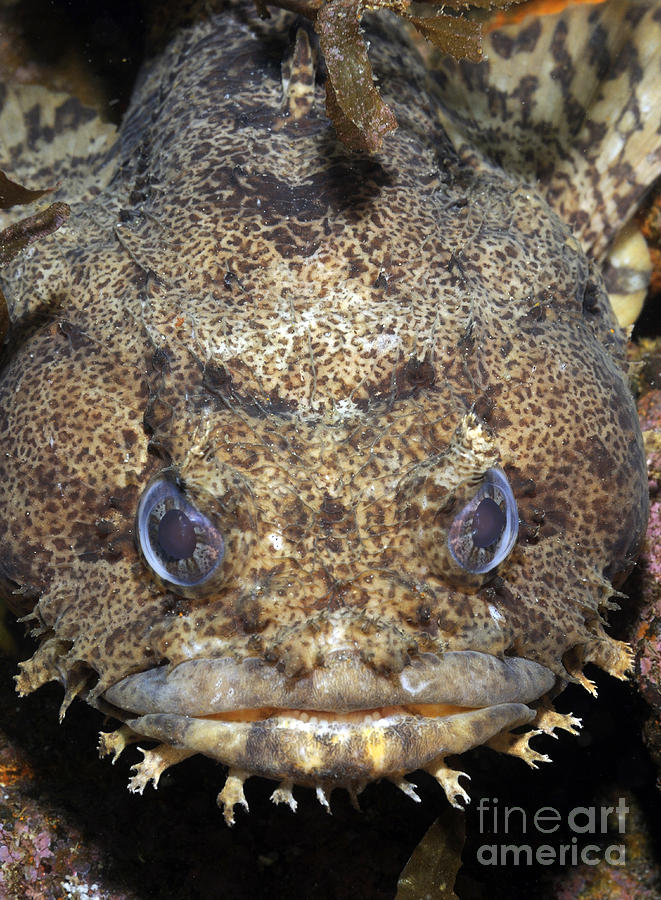
Credit: Karen Doody
Opsanus tau, commonly referred to as Oyster toadfish, Oyster toad, Ugly toad or Oyster cracker, is a Northwest Atlantic species of fish of the family Batrachoididae. The Oyster toadfish has a plump belly and a large, flat head and is generally olive brown to yellowish in color, with brown oblique bars markings. It can attain a maximum length of 43.2 cm (17 in) and its scaleless skin is covered in a thick mucus and occasionally warts, hence the name “oyster toadfish.”
Its other features include a rounded nose and an enormously wide mouth with numerous blunt teeth. This fish has such strong teeth and powerful jaws that it is able to crush the hard shells of mollusks and even engage in fights with other oyster toadfish. Their predation technique consists of camouflaging themselves and lying motionless, waiting for their prey to swim by, and then attack by surprise. Toadfish have a venomous spine on their first dorsal fin, and the venom inflicts pain that is comparable to a bee or wasp sting.
7. The Striated frogfish (or Hairy frogfish)
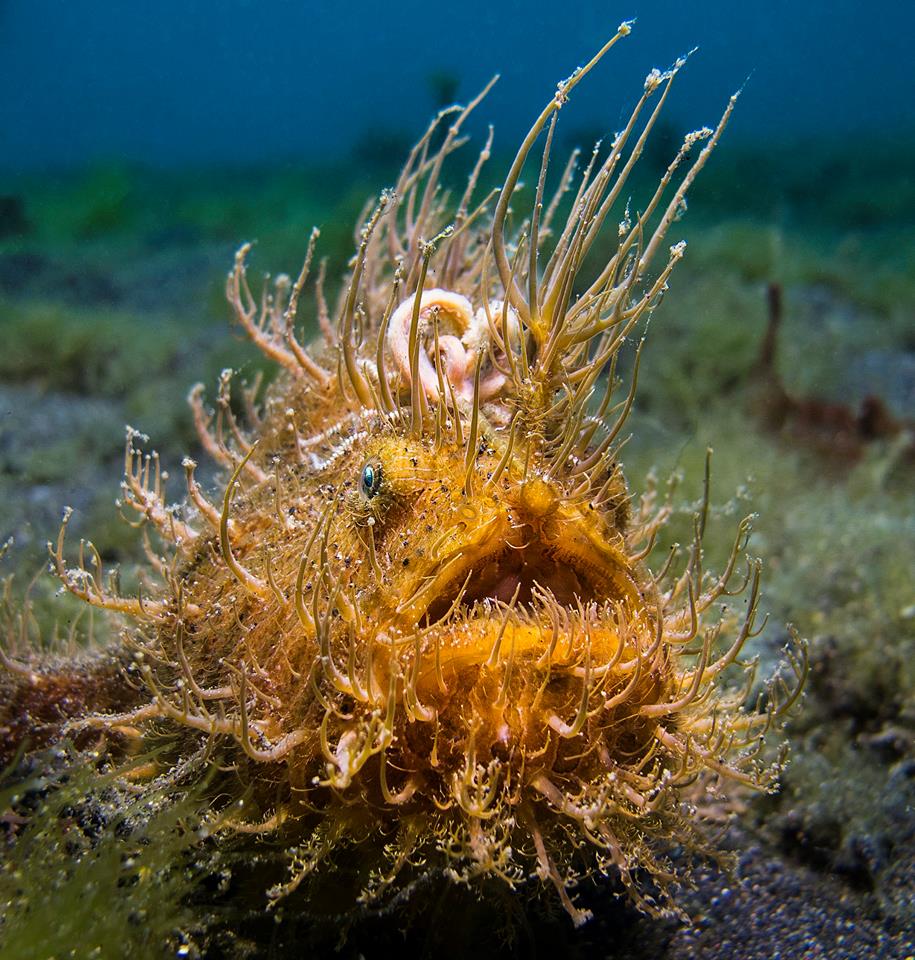
The Striated frogfish or Hairy frogfish (Antennarius striatus) is a marine fish belonging to the family Antennariidae. It can reach up to 22 cm (8.7 in) long, though the most common length is of 10.0 cm (4 in). This small fish is of varied coloration ranging from yellow to brownish-orange, gray, green, almost white or brown, with or without black stripes or elongated blotches. As well, it can alter its coloration and pigment pattern to blend in within its surroundings.
Its spherical body is profusely covered in protrusions and frilly appendages, while its modified pectoral fins appear like little legs. The frogfish does not have typical dorsal fins, instead they are equipped with three fins, with the front-most one, called the illicium, that serves as a fishing rod that has a fleshy, worm-like appendage (the esca) at the extremity. To attract prey, the frogfish remains still and flips and waves the illicium to make the esca appear lifelike. The unsuspecting prey approaches to bite at what it thinks is a meal, but instead the frogfish quickly devours it. In fact, the esca is composed of 2-7 worm-like appendages and which can be regenerated if lost.
8. Barreleyes
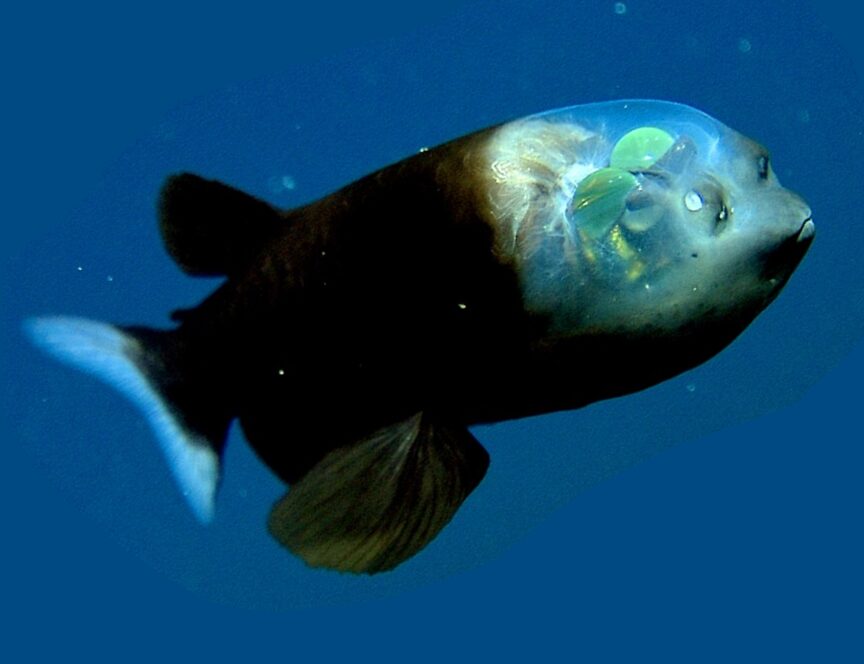
Credit: Monterey Bay Aquarium Research Institute
Barreleyes, also called Spook fish, are known for the peculiar eyes and very unusual appearance. They are a small deep-sea argentiniform fish, being part of the family Opisthoproctidae and found in tropical-to-temperate waters of the Atlantic, Pacific, and Indian Oceans at extreme depths of 1800 to 2600 ft.
They obtain their name because of their barrel-shaped, tubular eyes, which are usually directed upwards to detect available prey and are capped by bright green lenses. These telescopic eyes protrude from the head and are visible through a large transparent, fluid-filled dome extending from its mouth to the top of the head. When the fish is searching for food overhead, the eyes are pointing upward, but they can be rotated to point forward when it is feeding. Its exceptionally light-sensitive eyes consist of a green pigment that may be helpful in filtering out green waves from surface light, and this aids in seeing bioluminescence in jellies and other deep-sea creatures.
9. Frilled shark

Credit: Awashima Marine Park/Getty Images
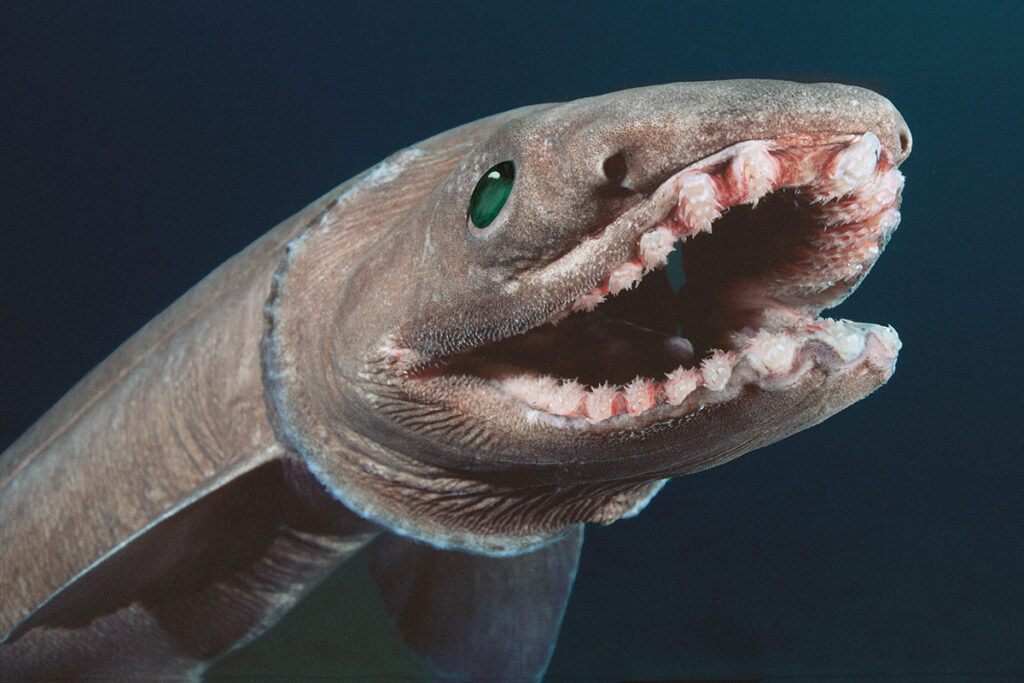
Credit: Kelvin Aitken/VWPics/AP
The Frilled shark (Chlamydoselachus anguineus) is often referred to as a “living fossil” due to its primitive physical appearance that has changed very little since the prehistoric times. This one-of-a-kind sea creature has an eel-like body, which can attain a maximum length of 1.7 m (5.6 ft) in the male and of 2 m (6.6 ft) in the female. The skin color ranges from uniformly dark-brown to uniformly gray and it has dorsal, pelvic and anal fins located towards the tail.
The name “frill” may allude to some decorative ornament on a beautiful dress, and in fact, this is one of the similarities that gives the frilled shark its common name – six pairs of gill slits at the shark’s throat create a fringed appearance. The first pair of gill slits form a collar, while the extended tips of the gill filaments form a fleshy frill. When on the hunt, the creature moves like an eel, curving itself and lunging at its prey, and devouring its meal which can be half as long as its body, if not greater than its own size. Its long and flexible jaws are equipped with 25 rows of recurved, needle-like teeth – 300 in total.
10. Sloane’s viperfish
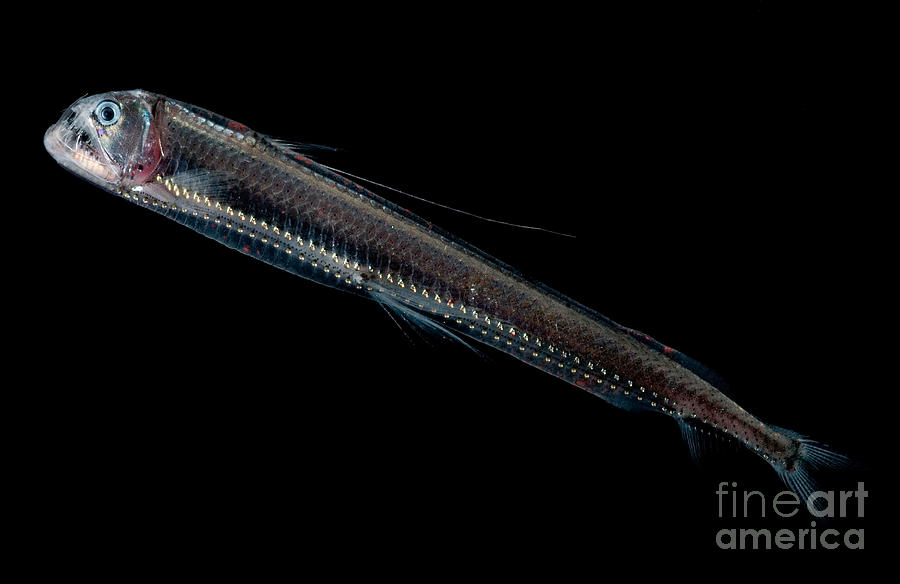
Credit: Dante Fenolio
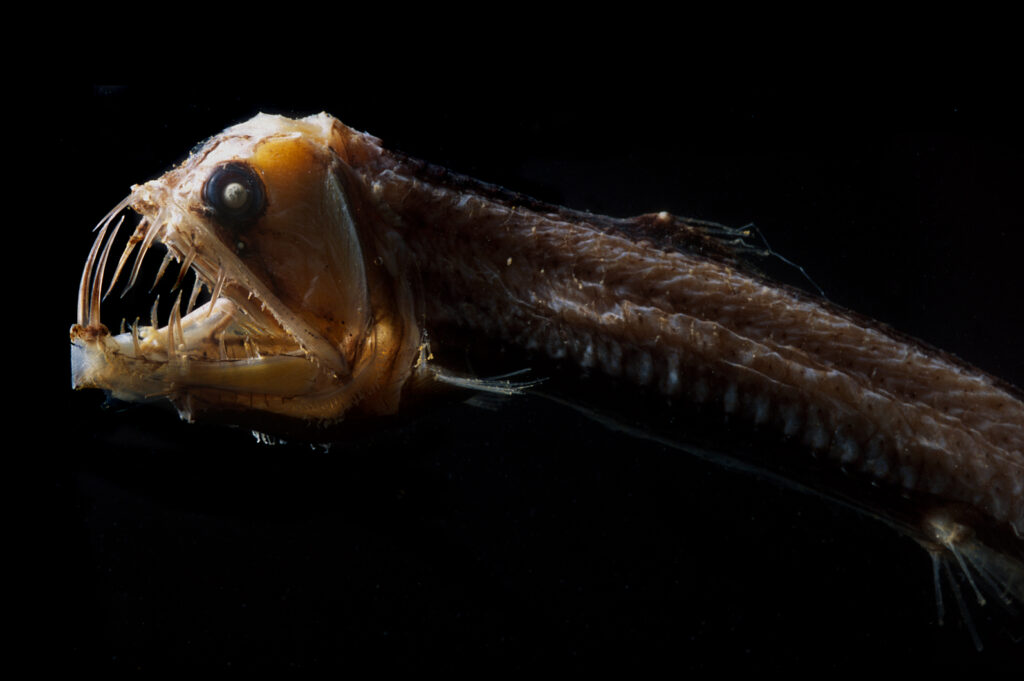
Sloane’s viperfish (Chauliodus sloani) is a predatory, mesopelagic dragonfish found in tropical and temperate waters around the world, at depths of 200 m to 1000 m. This species can reach 6.4 cm to 26 cm in size and is of an iridescent silver-blue color, with two rows of photophores on either side of its ventral region and has a long dorsal fin ray almost to half the body length.
The most striking feature in the Sloane’s viperfish is its large mouth with long, fang-like teeth. When the jaws are closed, the teeth interlock together to form like a cage, trapping the prey inside. As the jaws can be unhinged, it is capable of opening its mouth up to 90° to capture prey up to 63% its own body size. However, the teeth are immobile and attached firmly to the jawbone, which allow the fish to open its jaw so wide. The Sloane’s viperfish attracts its prey with its photophore, or by positioning and swaying its long dorsal fin in front of its mouth.
11. Goblin shark
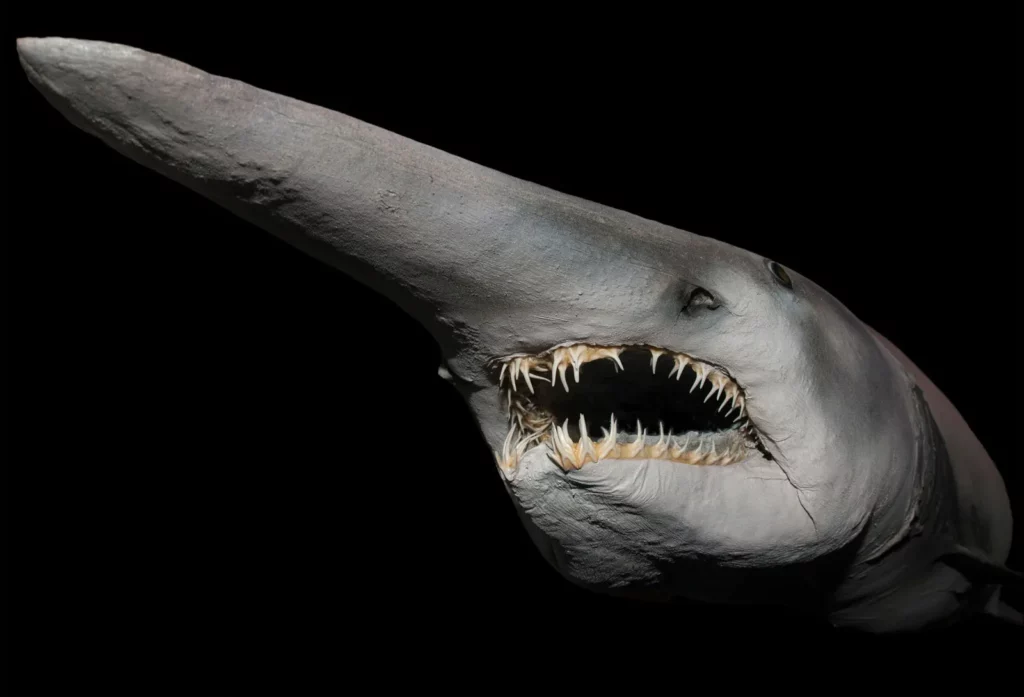
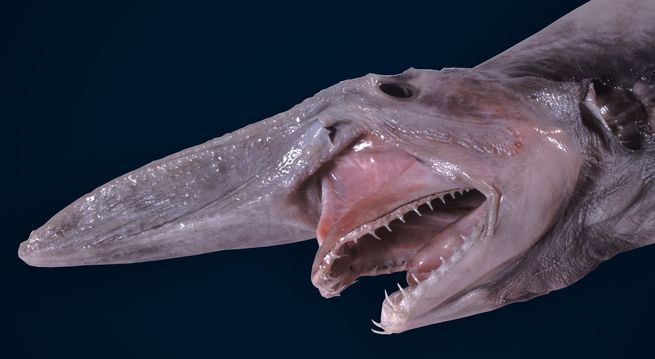
Credit: Courtesy Museums Victoria
The Goblin shark (Mitsukurina owstoni) is a benthopelagic creatures, the only extant member of the family Mitsukurinidae, a lineage of 125 million years old. This rare species of deep-sea shark is found at depths greater than 100 m (330 ft), with adults measuring between 3 and 4 m (10 and 13 ft) in length.
Its distinct feature is the elongated, flat snout and extremely protrusible jaws equipped with jutting, long pointy teeth. As the shark ages, the length of the snout also proportionally decreases. The jaws are usually held at a position under the eye, but they can be extended almost to the end of the snout. The Goblin shark is believed to be an ambush predator, since it is not a fast swimmer. It awaits for the prey to come into range, and then the jaws lunge forward to capture it. In fact, the Goblin shark can thrust its jaws forward faster than any other species of shark. As well, the shark most likely hunts its prey by sensing electric fields through the underside of the snout, which consists of numerous pores that are external openings for the electricity detecting organs.
12. Red-lipped batfish
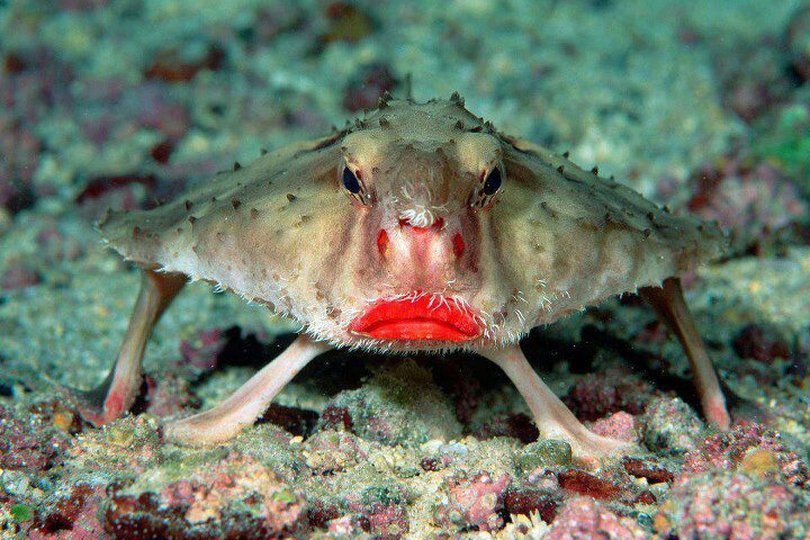
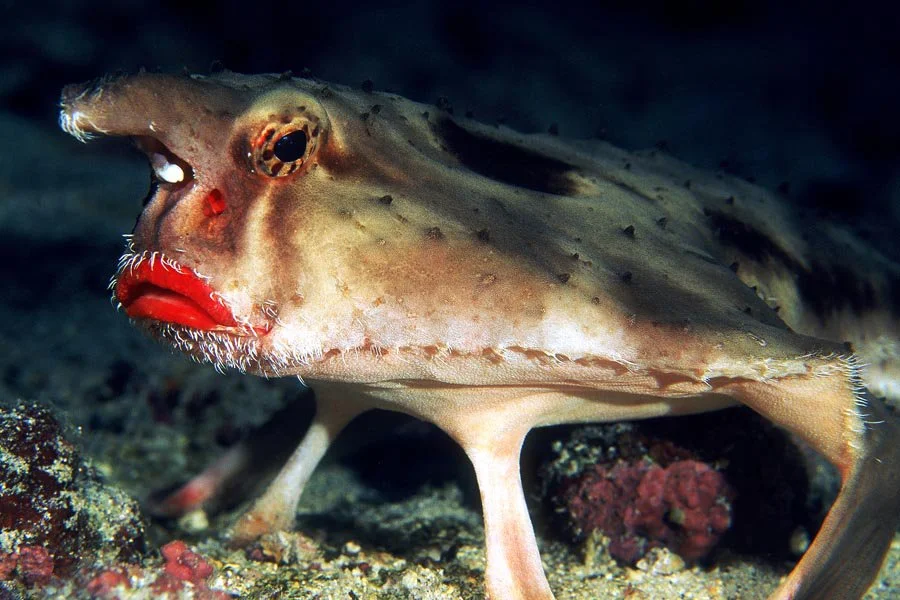
The Red-lipped batfish or Galápagos batfish (Ogcocephalus darwini) is a fish of truly unusual shape and appearance found in the Pacific Ocean around the Galápagos Islands and off Peru at depths of 3 to 76 m (10 to 249 ft). Its most striking feature is its brilliant red lips that are believed to be used to enhance species recognition during spawning and also attract sexual tension within the species. This species reaches up to 40 cm in length and its body color is light brown and grayish on the back, with a white underside. A dark brown stripe extends from the top of the head and runs down the back to the tail.
Red-lipped batfish are not good swimmers, and they prefer to use their pectoral, pelvic and anal fins that are highly adapted to serve as pseudo-legs so they can “walk” on the ocean floor. On top of its head is a specific appendage known as an illicium which has an esca at its extremity. The illicium has for purpose to lure prey, with the esca emitting a bright light which attracts other fish towards the Red-lipped batfish in deep waters and allows it to capture the small creatures.
Src: illuzone.net








